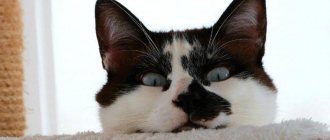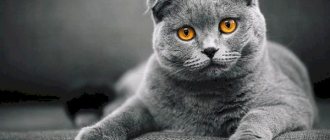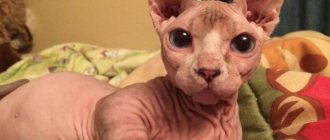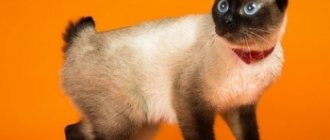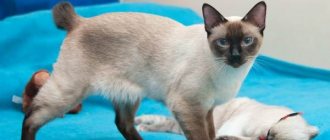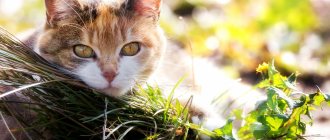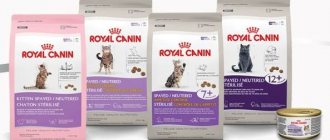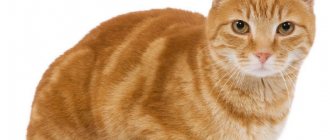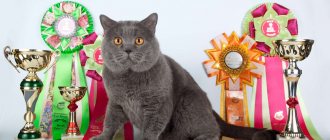- Pets
- >>
- Cat breeds
* Here is a photo of a typical representative of the Neva Masquerade cat breed . You can send us photos of your animals by email, and we will post them on the website. Don't forget to send your pet's name.
Video
* We invite you to watch a video about the Neva Masquerade cat . In fact, in front of you is a playlist in which you can select and watch any of 20 videos about a given cat breed by simply clicking on the button in the upper right corner of the window. In addition, the material contains quite a lot of photos. By looking at them you can find out what the Neva Masquerade cat looks like.
Rate the material!
[Total votes: 1 Average: 5]
The Neva Masquerade cat is an aristocrat of the cat world. These mannered, graceful animals were bred in Russia and acquired unique character traits. For all their aristocracy, they remain harsh hunters and dangerous predators, capable of standing up for themselves. At the same time, they combine such character traits with the tenderness and attentiveness that goes to the owners of the cat.
Advantages and disadvantages
The advantages of the breed include:
- attractive and unusual appearance;
- quick adaptation to any conditions, comparative unpretentiousness (the only thing is that a cat needs a lot of space, this must be taken into account);
- good, friendly, rather gentle character;
- good health, long life expectancy.
Among the minor disadvantages of Neva masquerade cats, the following can be noted:
- the need to provide the cat with space and active activities;
- some phlegmaticity;
- Constant care for your pet's luxurious coat.
These shortcomings can hardly be called critical. People who want to get this furry miracle just need to carefully prepare for purchasing a pet and take into account some of its special needs, which is actually not that difficult. It is worth noting that purchasing a purebred purebred animal is quite difficult; you should carefully choose a nursery or breeder, based on recommendations and reviews.
History of the origin of Neva masquerade cats
The Neva Masquerade cat appeared relatively recently - at the beginning of the twentieth century. This breed was gaining popularity in Europe, America and Russia. Cats of this breed began to be bred on a large scale in 1986, and were officially recognized only in 1988. However, not all associations still recognize this breed as official.
The history of the Neva masquerade cat is well known. It descended from Siberian cats, which were an indigenous breed found only in Siberia. These cats became the progenitors of many modern breeds of semi-longhaired and longhaired cats. Siberian cats lived in Russia for centuries, but became known only from the time of Peter I.
The origin of the Neva masquerade cat from a geographical point of view is difficult to establish. Their breeding was first started in the city of St. Petersburg, in the then popular club “Kotofey”. The breeder was Olga Mironova, famous at that time, who had a hand in many cats.
Interesting fact: The cats were named Neva cats in honor of the Neva River, where these animals originated. The masquerade cat was named due to its unusual color: a spot on its face that resembles a dark mask.
Subsequently, the cat was bred in Moscow. Moscow nurseries carried out selection separately from St. Petersburg ones, which contributed to some division of the breed, but at the same time added diversity to the genetic potential.
In addition to the Siberian cat, Siamese cats have also “invested” in the Neva Masquerade cat breed. In many ways, they influenced the color of the Neva Masquerade: dark muzzle, paws and tail. It is reliably known that Neva Masquerade cats are an exclusively Russian breed.
Cost of a kitten
You should purchase a Neva Masquerade pet from large nurseries or from well-established breeders who breed and sell these cats. There are quite strong differences in the cost of kittens due to gender, class, rarity of color and other factors.
Prices also vary from region to region; in large cities, purchasing a cat will most likely be more expensive, this depends on the pricing policy of the cattery.
A cat without a decent pedigree will cost 2-5 thousand rubles (sometimes prices reach 10). You can buy a show class kitten for 25 or more, breed class costs from 15, pet class – from 5-7.
Neva Masquerade cat - description of the breed
Neva masquerade cats have many differences from their closest relatives: Siberian and Siamese cats, although they inherited a lot from them. This is a fairly large breed. The weight of cats is approximately six kilograms, and the weight of cats is up to nine kilograms. They are proportionate and strong. The body is of medium length, not too stretched. The torso is massive, the neck is short and thick. Volume breasts and strong muscles.
The head is proportional, but massive, wedge-shaped and with smooth, rounded features. The forehead is round, low; wide nose of medium length, without humps. If you look at the cat in profile, there is a noticeable deepening in the transition from the forehead to the nose, but the transition is smooth. The cheekbones are set low, there is a fleshy cheek area, and the jaws are well developed. The chin is also smooth, but powerful and not protruded.
The ears of the Neva Masquerade cat are of medium size, very wide at the base and slightly tilted forward. The tips of the ears are softly rounded. The distance from ear to ear is small. The eyes are round and slightly slanted in setting. Eye color is necessarily blue, but can vary in shade. Up to a year, a green tint to the eyes is acceptable.
The legs of the Neva Masquerade cat are of medium length, very strong and muscular. Their paws are large - they inherited this from Siberian cats. The paws are round in shape, and soft hair grows in tufts between the toes. The tail of these cats is of medium length, well furred, widening towards the end and rounded at the tip. Owners note that this tail resembles a fox's.
Breed card
| Characteristics of a cat | Notes | |
| General information | Historical “Russian” breed previously practically unknown outside of Russia | Neva masquerade cats are a subspecies of Siberian cats |
| Character | Affectionate, purrs loudly, attached to owner | Gets along with dogs |
| Appearance | Very similar to the Norwegian Forest Cat. Large cats with strong bones, thick Siamese hair and blue eyes | Cats appear larger in winter as their fur becomes longer. The final color of a kitten's coat is difficult to predict, as the coat darkens at lower temperatures. |
| Behavior at home | An active breed, cats jump well. Curious character, but will be treated colder with strangers than with members of the household | Get along well with children and other pets |
| Care | Thanks to its special structure, the wool does not mat, making it easier to care for. The coat should be combed 1-2 times a week and washed as needed. | Molts twice a year. Be prepared that there will be a lot of wool in the apartment and on your clothes |
| Health problems | Hypertrophic cardiomyopathy | The disease is associated with hereditary thickening of the heart muscles |
Popular colors of Neva Masquerade cats
The coat of Neva Masquerade cats is medium length and fluffy. They got it from a Siberian cat: it shines brightly and has the ability to repel water. Thanks to this, Neva masquerade cats hardly freeze, but they also do not like to swim. The coat lengthens, moving from the shoulder blades to the pelvic part, and smoothly falls to the sides and to the base of the tail. The fur around the neck forms a thick mane. Soft trousers are clearly visible on the hind legs.
This type of fur is called decorative fur: it is intended for aesthetic purposes, and not for keeping the cat warm. During the molting period, the panties from the hind legs and the shirtfront from the chest almost disappear. The cat's undercoat is long and thick, especially growing in winter, becoming denser. In summer, the cat sheds, and the undercoat becomes thin and light.
The guard hair and undercoat of the Neva Masquerade cat are light in color, and the tips of the ears, paws, tail and fur on the face are dark.
Depending on the darkness of the color, all colors of Neva masquerade cats can be divided into the following:
- Seal point and seal tabby point with classic chocolate and dark chocolate spots;
- Blue point with gray spots;
- Red point with red spots;
- Tortoiseshell point, which is found only in cats and not in cats.
Relatively recently, breeders have developed several colors that have silvery shades. Only the chocolate-lilac color scheme is excluded from the breed, and all other shades of masks are acceptable. The only condition: the contrast between the light coat and dark tones must be clearly visible so that the border is drawn.
Breed characteristics
Standard
Description of appearance:
- Body: individuals are large, strong, males reach 8-10 kg, females are smaller than males and reach 6-7 kg, the muscles are good, the bones are strong, the body is medium in length, the physique is dense, massive, the limbs are medium in height.
- Head: trapezoidal, short and wide, low forehead, smooth profile with a slight depression, short and strong neck.
- Ears: medium, with a slight forward inclination, the base of the ears is wide, the presence of tassels and brushes.
- Eyes: round in shape, large, set obliquely, color: uniform, rich blue.
- Tail: wide, well feathered.
- Coat: semi-long, soft and dense on the sides, loosely fitting, tufts of hair on the paws, a collar and thick pants.
Due to the fact that the founders of the breed are native Siberian cats, the semi-long coat of Siberian Color Points meets the harsh climatic conditions of Siberia. The shiny and water-repellent topcoat from the shoulder blades to the croup becomes longer and descends to the tail and sides.
In the warm season, the double undercoat is short and close-fitting; in the cold season, it becomes longer, thicker and denser, and its texture becomes richer. Siberian Color Points have decorations - a mane, frill and panties. Their coat is long, lush, dense and sheds heavily.
The color of Neva masquerade cats has several options:
- seal-point – light body combined with dark muzzle, socks, ears and tail;
- seal tabby point - ivory coat with striped markings;
- red-point – a rare color with red points;
- Blue-point – cold, “blue” shades of wool;
- tortoiseshell (Tortie-point) – tri-colored Neva masquerade cats (almost always girls).
Photos of Siberian color-point colors
Here's what the 5 popular colors of this breed look like:
seal point
seal tabby point
red point
blue point
tortoiseshell color
At birth, kittens' fur is always white, since the color gene is sensitive to high temperatures, and pigmentation does not penetrate into the hair structure until the temperature changes to colder. Chocolate-lilac tones are not recognized as a standard. Also, the standard does not allow the Persian type and the absence of undercoat.
Health
The average life expectancy of Siberian Color Points is 10-13 years. Under good conditions and proper care, the age of some representatives of the breed reaches 20 or more.
This is due to the fact that these cats have good immunity and extremely low susceptibility to disease. However, one serious hereditary disease - hypertrophic cardiomyopathy - can lead to sudden death if diagnosed untimely and untreated.
Important! Hypertrophic cardiomyopathy does not show pronounced symptoms. Be sure to have your pet checked by a specialist.
Weight by month
See the table of changes in the weight of the Neva Masquerade cat by month. Error +-10-20% depending on the cat’s nutrition and care. Also, the kitten's weight will grow 10-20% faster if spayed/neutered.
| Kitten age | Male cat weight (kg) |
| Newborn | 0.12-0.16 |
| 1 Week | 0.2-0.26 |
| 2 week | 0.3-0.36 |
| 3 week | 0.44-0.62 |
| 4 week | 0.62-0.74 |
| 2 months | 1.2-1.6 |
| 3 months | 1.8-2.3 |
| 4 months | 2.5-3.8 |
| 5 months | 3.0-5.5 |
| 6 months | 3.9-6.2 |
| 7 months | 4.2-6.6 |
| 8 months | 4.5-6.9 |
| 9 months | 5.0-7.4 |
| 10 months | 5.2-7.9 |
| 11 months | 5.7-8.4 |
| 12 months | 5.8-9 |
| Weight of an adult cat and cat | 5.9-10.0 |
Character
The ideal portrait of the owners of the Neva Masquerade is a family with children. According to breeders, cats have an easygoing character and, despite their “Siamese” color, are not at all vindictive.
Self-determination in the home is important for the Siberian Color Point. He will not tolerate a familiar attitude towards himself from people unfamiliar to her. Cats show love, affection and even care to their owners if communication occurs on equal terms. In the relationships of several cats in the house, a hierarchy inevitably arises.
If you once allow a cat to sleep on the owner’s bed, then in the future this will be its favorite sleeping place, so whether you decide to limit your pet in this or not - you need to immediately and never deviate from this decision. The situation is the same with other prohibitions. Therefore, it is worth training a kitten and accustoming it to a scratching post and tray as early as possible.
Representatives of the breed are endowed with good manners. Owners note the high intelligence of their pets. They are easily litter trained. Cats are happy to “tell” how their day went and are interested in the life of their owner. They try to calm an excited person by purring and jumping on their knees.
Siberian Colorpoints get along with children, treat them with patience, tenderness and understanding and play with them with soft paws without claws. They also have excellent adaptability and are good with other pets.
Nevaks, as felinologists call Siberian color-point cats, always actively defend their interests and their territory, protecting not only their offspring, but also their loved ones. These brave animals can fight even with large dogs.
The Neva Masquerade itself chooses its favorite family member, defining him as its owner. He gets very attached, picks him up from work and sees him off, and gets sad when separated for a long time. Nevaks are incredibly curious by nature. Extreme situations do not bother them, and panic is unacceptable for these aristocrats.
Character and habits of Neva masquerade cats
Neva masquerade cats have graceful habits. They have a pronounced sense of self-esteem, which does not allow them to behave with these cats like children. With all their appearance and behavior they demonstrate nobility.
Only close people, owners and their children can freely play with this cat. With others, the animal behaves distantly and imposingly, does not show increased interest in new people, and also does not always allow itself to be stroked and, especially, to be picked up.
Neva Masquerade cats are sedate and proud animals with a balanced character. They are attached to family and to home comfort and silence. They like it when they are given attention, but do not ask for it intrusively. They sense the territory well and will not allow new animals into it: there is a high probability that they will respond aggressively to other cats and dogs.
Interesting fact: Owners of Neva Masquerade cats note that the animals love to listen carefully to their owners, are ready to provide emotional support and happily sit on the laps of their loved ones, purring quietly.
Despite their external appearance, Neva masquerade cats are very playful and love to move. Therefore, they get along well with children who are ready to constantly play with their pet. These cats are also characterized by curiosity about everything that concerns their owners: they are nearby when people are doing household chores.
Neva masquerade cats can hardly be called sissies or timid animals. From their ancestors - Siamese and Siberian cats, they received a harsh character and high adaptability to new conditions. You don’t have to worry about these cats if you let them go for walks near a private house. They can fend for themselves and have sufficient intelligence, although supervision of walks is still necessary. Neva masquerade cats themselves do not show aggression unless provoked.
Being good hunters, they can bring mice, birds and even moles into the house. You definitely shouldn't leave them near pet hamsters or parrots.
Character
Representatives of this breed have a rather peaceful character, they are freedom-loving and independent, completely independent and self-sufficient. Some can be quite capricious, stubborn and self-willed, but patient accustoming to the rules established in the house, toilet, hygiene procedures and other rules of behavior from early childhood has a positive effect on the cat’s behavior.
Sometimes it is quite difficult to accustom them to order, but patience and love can overcome any obstacles. Education should begin from a very early age, then the animal will quickly understand what they want from it.
Like other large cats, Neva masquerade cats are very smart and quick-witted, and have high intelligence. They love their owners very much, they often feel their mood, they will never demand undue attention and get in the way, preventing them from doing business.
Cats of this breed are very calm, balanced, have self-esteem and aristocratic manners. Their nervous system is so strong that many call them phlegmatic.
Indeed, these cats do not pester people; they know how to find something to do for themselves. They will not impose themselves, but they feel bad when alone. The cat needs to know that there is someone at home.
They are very friendly towards their owners and become very attached. They are loyal, will never take revenge or mischief, and are quite patient. These are wonderful companions who, however, require a relationship of equals. These cats are wary and distrustful of strangers and rarely agree to affection from strangers.
If there are children in the house, you can safely leave them with a representative of this breed. A proud descendant of Siberians will never offend a child; on the contrary, he will take care of and protect him in his own way. If children are very small and can cause discomfort or pain to the cat, then it is better to protect the animal from communicating with them, but this applies to any cats and animals in general.
It is the cat that needs to be removed, since she herself will never harm the baby, she will prefer to run away, but will not bite or scratch. These cats get along well with older children and can play and run around.
Despite their excellent hunting skills, Neva Masquerade cats get along well with any other living creature living in the house, even rodents and birds, not to mention dogs and other cats.
Interesting facts about Neva masquerade cats
The temperature at which kittens develop in their mother's womb has a curious effect on them. Small kittens are born completely white, rarely with a beige tint. Only later do dark spots appear on them, which distinguish the Neva masquerade cat from other breeds.
The color of representatives of the Neva Masquerade cats is a consequence not only of crossing Siberian cats with the Siamese breed. Neva masquerade cats have a special gene with thermal sensitivity. This gene prevents the pigment from penetrating the hair structure at high temperatures. Therefore, only the coldest areas, those exposed to the lowest temperatures, have a dark color: the muzzle, paws, tail and tips of the ears.
By nature, Neva masquerade cats are born aristocrats. Thanks to their habits, these cats are well brought up and will never go against their owners. For example, they almost never tear up furniture and are easily litter trained. Innate cleanliness greatly facilitates their maintenance - these manners are inherent in Neva masquerade cats at the genetic level.
Neva masquerade cats have a keen sensitivity to emotions. They always determine what mood the owner is in. And if they understand that people close to them are feeling bad, they are ready to lighten the mood with affectionate purring or flirting. They even relieve irritability or fatigue with their purring.
Cats of this breed are strong and dangerous predators. They should not be angered, since a cat can cause serious damage even to a person. Of course, the animal will not touch children or loved ones, but it is wary of strangers. Therefore, there is no need to insist on contact with the Neva masquerade cat if she does not want it herself.
The history of the appearance of the Siberian cat
One of the oldest breeds known to man, formed naturally. Many legends and myths have developed about the appearance of this cat next to a person. Its characteristic appearance and powerful large body gave rise to a legend about its relationship with the Siberian lynx.
But the Siberians themselves in ancient times called this cat Bukhara, which came from Bukhara, foreign. The first mention of this domestic animal in handwritten sources dates back to the sixteenth century. It is not possible to establish the exact time of appearance of the species. The population of Siberia mainly led a nomadic lifestyle; there were only a few large settlements - camps (khan headquarters), where livestock, dogs and cats were kept.
There are several versions of how a long-haired cat was able to get into the taiga and survive there. Three of them are noteworthy:
- They appeared in Rus' in the eleventh and twelfth centuries as Byzantine gifts to the ruling princes. Females with Persian roots actively crossed with forest semi-wild cats.
- Domestic cats of immigrants to Siberia from the West naturally crossed with wild forest cats, the genotype changed, adapting to harsh climatic conditions.
- The ancestors of the Siberian were brought by Eastern merchants during the period of active trade (Silk Road) and have Asian roots. It is very likely that Siberian, Persian and Angora cats have common roots. The animals adapted to local conditions through a process of natural mutation. Snow, frost, and a long winter in the Urals and Siberia contributed to the appearance of long hair with water-repellent properties and a thick, warm undercoat that warms the animal in bad weather. And Vologda merchants brought Bukhara kittens to middle and central Rus'.
The unconditional hunting gift of these mighty beauties has always been highly valued by man and is their undeniable advantage. During the Great Patriotic War, it was these cats that saved the country from a rodent invasion. After the liberation of Leningrad from the siege, the furry Siberians were donated to the residents of the city for the next battle for human life - this time with rats.
Moscow and St. Petersburg Siberians became representatives of this breed from Russia at world felinological exhibitions.
The path to the official formation of the breed:
- The first of the first was the cat Roman (born in 1987). In the same year, the first nursery “Nevsky” opened in Germany.
- In 1989, felinologists of the Soviet Union proposed the name of the breed “Moscow”, it was rejected and officially assigned “Siberian”.
- In 1992, Siberian Dimka Laskovy Zver became the first World Champion in the WCF system. One of the Siberian subspecies, the Nevsky Masquerade, is registered as a separate breed.
- 1995 - the first special breed exhibition “Siberian Miracle” began its work in Moscow.
- In 1996, the breed was officially registered in the international felinological system TICA.
- 1997 - recognition in the FIFe association and the opening of the first club for breed lovers;
- 2006 - recognition by the American CFA system. Siberian Fenya Lynx wins world and European champion titles.
Thanks to his unique appearance and character, which deserves respect, the Siberian hunter has more than once become the hero of folk tales and even entered classical literature - it was he who became the prototype of the “scientist cat” from A. S. Pushkin’s poem “Ruslan and Lyudmila”.
This handsome man is rightly called the national treasure of Russia.
Pros and cons of Neva Masquerade cats
The undoubted advantage of such a cat is its bright, attractive appearance and expressive eyes. She always attracts the attention of others and looks very impressive.
In addition to appearance, the Neva Masquerade cat has the following advantages:
- These are calm, sedate animals that will not cause chaos in the house;
- They are gentle and meek, very courteous with close people; patient, so they can endure playing with children for a long time, even if they don’t like it;
- They are not capricious at all, so they do not refuse food and can live in a wide variety of conditions. Therefore, there are no special requirements for maintenance - cats easily adapt even to life in a private home and to walking on the street;
- Neva masquerade cats have strong immunity and good health; cats of this breed are excellent hunters. By keeping them on private property, you can be sure that there will be no small rodents left on it;
- These cats have another interesting feature - they know how to choose a healthy mating partner who will provide the best offspring. An adult cat will never associate with a sick or aggressive cat.
The disadvantages of the Neva masquerade cat include:
- Large sizes, due to which these cats require space - at least seven meters for comfortable housing;
- Sometimes they are indifferent to their owners and require privacy. They don’t like strangers, and contacts with them can be viewed with hostility;
- They need to be combed out as often as possible;
- These cats should not be kept with other animals. They will eat smaller pets, and will treat larger ones with aggression and rejection;
- It is very difficult to find a cat with a proven and good pedigree for mating.
How to choose a kitten
Buy a Neva Masquerade kitten after he is 3 months old. Until this age, it is better for him to stay with his mother cat and sisters and brothers. If the seller offers you a baby who is not yet 2.5 months old, this should alert you.
Neva masquerade kittens with mother
Neva masquerade kittens are born snow-white, without any spots or marks. Even at a very early age, they look much larger than babies of other breeds.
To be sure of the purebred and health of your newborn kitten, contact the nursery. Here he will be accompanied by a veterinary passport, birth certificate or pedigree. The veterinary passport must indicate that the animal was dewormed, that is, it was given an anthelmintic drug. The passport must also contain documentary evidence that the baby has received all the necessary vaccinations at this age.
When visiting the nursery, make sure that the atmosphere there is calm, the kittens are not shy, they are not shy of you, and they are not nervous because of extraneous sounds and your sudden movements. These observations will confirm that they do not grow in a cage, but in comfortable conditions.
Having decided on one of the kids, start a game with him, during which the peculiarities of his character may appear. Get to know the mother of your chosen one better: look at the cat and observe her behavior, because character traits, both good and not so good, are inherited.
Breeding Neva Masquerade cats
The first heat of the Neva masquerade cat begins already in the ninth month of life. This is not at all a reason to breed a cat - her body is not ready for pregnancy and childbirth. On the contrary, early pregnancy is fraught with serious complications or even death. During heat, a cat becomes active, rolls around on the floor, screams a lot and demands attention. The cat is ready for mating only after the third heat, when the body has finally formed and the reproductive system is ready for pregnancy.
Neva masquerade cats mature later. You can determine that this happened by the cat’s behavior: it marks its territory, screams and tries to escape into the street. Sometimes a cat can become aggressive and start biting and scratching. The instinct of self-preservation almost disappears, so you need to be careful when handling such a cat.
Neva Masquerade cat for cats can be found from professional breeders. He must have all the documents and vaccinations that will make the mating safe and the offspring healthy. It is also possible to breed a cat with outbred cats, but it is undesirable to waste the genetic potential of the animal.
Pregnancy lasts approximately 65 days. The cat noticeably gains weight, and sometimes may vomit on an empty stomach. After half the pregnancy period, the cat's nipples swell and the belly grows very large. On day 49 you can already palpate the kittens.
In late pregnancy, the belly becomes pear-shaped and the cat moves as little as possible. She may also lose her appetite completely, but she will drink large quantities of water. Childbirth takes place under the supervision of a veterinarian, although Neva masquerade cats rarely experience difficulties with it.
Colors
More than two hundred different colors of the Siberian are known. Some of them are not recognized by all felinological systems, others, due to their exclusivity, allowed subspecies to be distinguished into separate breeds. The most common types of colors:
Solid or solid
The entire coat is dyed the same color. There are two main types - solid black (black) and solid red (red or bright red). Solid blue is often found - it is a type of black, solid cream is a subtype of red.
Rich tones of black and red and lightened tones of blue and cream are appreciated. In all these colors, spots of other tones and colors are not allowed, the coat should not have a brown, faded tint - they need protection from the sun.
The eyes, paw pads and nose usually correspond to the color of the coat, but there are no strict restrictions on this trait in the breed standard.
Tortoiseshell or tabby cake
When two solid colors, red and black, combine, a red and black torti is formed. Blue and cream solids produce a blue-cream tortoiseshell color.
Spots of two colors are evenly distributed over the animal’s body, merging into a common melange background. Such colors are more typical for females; males are rare, but they do occur. The presence of a “tongue of flame” on the forehead is considered a plus. This coloring is often called tricolor.
Tabby
Marbled, brindle, spotted. The agouti gene is responsible for uneven coloring. It is its presence in the genotype of the animal that gives tabby.
- Classic marble is characterized by “butterfly wings” on the back and shoulder blades and concentric circles on the sides; they are darker than the main background.
- Brindle color - with alternating light and dark stripes throughout the body, more pronounced on the sides.
- Spotted (spotted) - dark spots mainly on the sides, on a generally light background.
All types of tabbies are found in four color variations - black, red, blue and cream.
Smoky and silver or smokey silver
These are tipping varieties - only the tip of the hair is colored, its base is white. Since two-thirds of the hair is colored, white is not visually observed, the animal is perceived as evenly colored. It is found in various colors and their combinations, including tortoiseshell.
Gold
Includes golden tabbies (more than half), golden shadeds and chinchillas. Gray shades in color are not allowed; eyes must always be green.
White
Very rare, highly prized. More often caused by dominant white and albino genes, less often it is a Siamese albino with no mask.
Bicolor
Always contains from one to two thirds white. It is found in the varieties harlequin (most white, colored head, tail, spots on the back and sides) and van (all white, colored only two spots behind the ears).
Color point
This is the Neva Masquerade cat - separated into a separate breed due to the characteristic Siamese color - the mask, paws and tail are darker than the main background.
Points
They have a black or brown mask, dark nose and paw pads. They are found in different color variations in four main types.
Tabby points
In addition to the mask, they have striped markings, usually on the tail and paws. Color combinations are different. On the forehead there is a pronounced letter “M”.
Animals of all color options are unique and inimitable in beauty. More than one Russian felinologist and breeder worked for many years to describe and characterize each type.
Caring for Neva masquerade cats
The Neva Masquerade cat does not require specialized care. It usually needs to be brushed two to three times a week using a range of items. The owner of a fluffy cat should have a slicker brush in his arsenal, which effectively removes dead fur.
You also need to get a brush made of natural stiff bristles, a rubber glove and a comb with fine teeth. You will also need shampoo if your pet gets very dirty, which is rare.
If you do not properly care for the coat of the Neva Masquerade cat, then cleaning the house will be required several times a week. The thick fur of these cats often falls out, which creates severe discomfort when keeping it in an apartment. Also, the fur has a tendency to roll into tangles, which causes inconvenience to the cat itself.
It is not advisable to comb the tail of the Neva Masquerade cat. It is very sensitive, and even the slightest hair pulling can be an unpleasant process for the cat. The hair on the tail rarely falls out and is poorly restored, so when combing it is better to simply avoid it.
Important fact: To prevent your cat from tearing up the furniture in the house, it is better to purchase a scratching post. Typically, these well-mannered and intelligent animals easily get accustomed to such devices and do not touch the furniture.
You should regularly clean your cat's eyes with a cotton pad moistened with warm water, and also clean your cat's ears and teeth. Solid foods and special chewing toys work best for cleaning teeth. Neva masquerade cats love walks. If you live in a private house, then you can let your cat out on its own - a smart animal will not go far from its territory and will behave carefully. Special leashes are great for walking in the city. These cats can be walked even in winter because they are not afraid of the cold.
Care and maintenance
The Neva Masquerade cat sheds twice a year, and care does not involve particularly complex procedures. Thick fur has no problems; you just need to brush it regularly. By itself, it does not roll, does not fall off, and tangles do not form on it. During the molting period, if these manipulations are not carried out, hairs will be everywhere - on clothes, furniture, carpet.
To prevent the pet's color from becoming darker, the animal needs to create warm conditions in the apartment. Such cats have good health, but it is necessary to adhere to the principles of proper nutrition and adherence to a certain diet.
Failure to do this increases the risk of certain health problems. As a ready-made food, it is important to choose premium and super premium food. A cat's diet should contain the micro- and macroelements, vitamins, and minerals they need.
Cats should not be fed food intended for humans - food from the common table can be harmful to health. The basis should be dietary lean meat. It can be boiled or raw, but heat-treated to reduce the risk of helminth infection.
It can be done either by deep freezing or scalding with boiling water before serving. Vegetables and cereal porridge are suitable as a side dish. Not recommended for cats:
- salt;
- sweet;
- smoked meats;
- fatty foods;
- fish;
- seafood.
Kittens from the same litter.
Small kittens receive food five times a day, for adult cats the frequency of feeding is 2-3 times. This breed is not prone to gaining excess weight, but it is better to feed it in portions of 150 grams. Neva cats like to walk in the fresh air. Even severe frosts are not a problem for them, since they are a type of Siberian cat that is not afraid of the cold. By nature they are good hunters, hardy, and have good reactions. If walking around the yard causes stress for your pet, it is better to avoid them.
Grooming should be done at least several times a week. During the molting period, it is better to brush daily. For this purpose, combs with frequent and rare teeth, soft rubber or silicone scratchers are suitable. Since the Siberian cat is a direct relative, these animals tolerate frost well. This is due to evolution and adaptation to the harsh climatic conditions of the region where they appeared.
Diet of Neva masquerade cats
To keep your cat healthy and its coat beautiful, you need to achieve a complete, balanced diet. Neva masquerade cats are prone to obesity, therefore, when choosing natural food, you need to pay a lot of attention to portioning and balance in food. It is best to feed your cat 120 grams twice a day for an adult pet.
Most of the Neva Masquerade cat's diet is meat. You need to choose lean meat rich in protein: chicken, turkey, beef. The easiest way is to place meat with cereals, such as oatmeal, rice, buckwheat. Legumes that cats do not eat in the wild should not be given.
An important element of the diet is vegetables. Cats especially love fresh cucumbers, which contain a lot of liquid and important vitamins. Greens are also an integral part of the diet. In the summer, it is better to let your cat eat grass on the run, and in the winter, pet stores offer pots of home-grown greens, which cats enjoy eating. Cats can also be given raw chicken yolk once every three to four days.
Interesting fact: In addition to meat, Neva masquerade cats love to eat offal. These include the lungs, liver, spleen, kidneys, hearts, tracheas, etc. They can be frozen well in the freezer and thawed to room temperature, or they can be boiled a little and cooled. Hot or cold food should not be given to your pet, so as not to damage the enamel of the teeth.
Fermented milk products are rich in calcium. Fatty components are excluded from the cat's diet, but low-fat cottage cheese, kefir and yogurt without any additives can and should be given. Once every three days it is worth treating Neva masquerade cats with these products. You can also give them a few drops of high-quality vegetable oil to remove hair from the body.
How much does a kitten cost?
If you decide to choose a Siberian as a companion, you should decide in what capacity you want to see him.
A pet-class kitten is only suitable as a pet. The price for it in Russian nurseries is fifteen to twenty thousand rubles.
For breeding, you need to choose a pet with an excellent genetic makeup - you should familiarize yourself with the pedigrees, color and type of parents. Find out if your cat has any birth defects. Depending on the color, uniqueness of the kitten, the fame of the nursery and the titles of relatives, the cost of the baby can reach one hundred thousand rubles.
The price of a show-class cat is approximately in the same range. With this pet you need to earn championship titles.
Siberian animals have a big advantage over other breeds - they are less likely to cause allergies. This is due to the low content of protein in saliva - the main factor of pathology.
On Avito today you can find offers to buy a real Siberian cat for three thousand rubles. You should not support scammers and scammers. This is one of the few Russian breeds that you can be proud of and need to support.
Photo gallery of Siberian cats:
Diseases and health problems
Neva masquerade cats originated through natural crossing of cats of other breeds. Siberian and Siamese cats, their closest relatives, also enjoy good health. Neva masquerade cats have excellent immunity, and they also have no congenital diseases. This is one of the healthiest cat breeds in the world.
Interesting fact: These cats can be let out for walks even in winter. Neva masquerade cats love to jump in the snow, especially when their owner is nearby. At the same time, there is no need to worry that the animal will catch a cold - the Siberian blood in these cats gives them excellent adaptability to cold weather.
It is worth keeping an eye on the amount of fur that enters the cat’s body when it licks itself. The fur can seriously clog the digestive tract or colon, causing illness or even death. Therefore, it is worth regularly giving her vegetable oil and special pastes that help remove hair from the body.
In large cats, a disease called hypertrophic cardiomyopathy sometimes occurs. This is a heart disease during which blood stagnates in the vessels of the heart, causing pulmonary edema. The disease is difficult to predict, so you should simply have your cat examined regularly by a veterinarian so that he can identify early signs of the disease. Otherwise the animal dies.
Since Neva masquerade cats love to walk, it is necessary to strictly observe prevention against parasites: both external and internal. Regularly give products that remove worms from the body, and also make sure that fleas do not appear in your pet’s luxurious fur.
Health and life expectancy
Siberian masquerade cats live about 13–15 years. Those with a stable immune system rarely get sick. If you provide your pet with adequate nutrition and properly care for it, its life expectancy can increase by another 3-5 years.
The only disease that is more common in Neva masquerade cats is hypertrophic cardiomyopathy. This is a pathology in which the walls of the left ventricle thicken, resulting in heart failure.
Important! The danger lies in the fact that cardiomyopathy does not manifest itself for a long time. The disease gradually progresses and can lead to sudden death.
Education and physical activity
The Neva Masquerade cat is endowed with high intelligence and is easy to train. She quickly adapts to new conditions, gets used to her nickname and gets used to the tray. True, under certain circumstances, a Nevak can be stubborn.
Cats of this breed are natural hunters with excellent reactions. To realize this instinct, Nevaks need to walk in the yard.
If this is not possible, then a corner equipped with shelves and ladders is allocated for the pet.
Vaccinations and antiparasitic treatment
In order to prevent infectious diseases, the Neva Masquerade is vaccinated against calcivirosis, panleukopenia and rhinotracheitis.
- The first vaccination is given to a cat at the age of 7-8 weeks.
- After 4 weeks it is repeated, but with an anti-rabies component.
- In the future, the Nevak is vaccinated once a year.
To prevent the appearance of fleas and worms, the cat is regularly subjected to antiparasitic treatment. Anthelmintic drugs are given to Nevak once every six months and repeated after 10-14 days. To remove fleas, special shampoos, drops and collars are used.
Feeding the cat
Nevaks are unpretentious in food. They eat regular foods and dry food with equal appetite. With a natural type of nutrition, the diet of a cat of this breed is designed so that it is dominated by fresh, lean meat.
Nevaka is also given:
- porridge with water;
- dairy products;
- boiled and pureed vegetables;
- offal;
- lean sea fish;
- eggs.
It is strictly forbidden to feed a nevak with pork, onions, chocolate, river fish, pickles, smoked meats, sausages, pastries, sweets and any leftovers from the master's table.
With an industrial type of nutrition, a masquerade cat is given premium or super-premium class products, which contain all the useful substances and no questionable ingredients.
The best food for nevaks is:
- Brit Care;
- Eukanuba;
- Royal Canin;
- Farmina.
